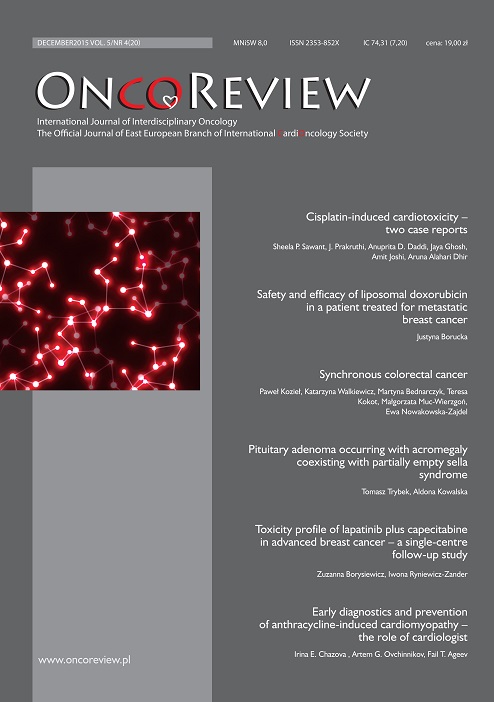Synchronous colorectal cancer Case report
Main Article Content
Abstract
Colorectal cancer is one of the most common neoplasms worldwide. It is still characterized by high mortality and causes ¼ of deaths due to neoplasms. Synchronous cancer is defined as presence of more than one cancer focus (not metastatic) in a patient at the same time. Prevalence of synchronous cancer amounts to 1.1–8.1% of all colorectal carcinomas. More often it affects elderly people and men. Risk factors include inflammatory bowel diseases, hereditary non-polyposis colorectal cancer and familial adenomatous polyposis. Molecular mechanisms underlying the synchronous lesions are: microsatellite instability (MSI), P53 and KRAS mutations as well as glutathione S transferase mutations (GST). In this article, we present a case of a 76-year-old woman with synchronous colorectal cancer in the form of tumors of the sigmoid colon and the ascending colon with metastasis in the liver
Downloads
Metrics
Article Details

This work is licensed under a Creative Commons Attribution-NonCommercial 4.0 International License.
Copyright: © Medical Education sp. z o.o. This is an Open Access article distributed under the terms of the Attribution-NonCommercial 4.0 International (CC BY-NC 4.0). License (https://creativecommons.org/licenses/by-nc/4.0/), allowing third parties to copy and redistribute the material in any medium or format and to remix, transform, and build upon the material, provided the original work is properly cited and states its license.
Address reprint requests to: Medical Education, Marcin Kuźma (marcin.kuzma@mededu.pl)
References
2. Ferlay J, Steliarova-Foucher E, Lortet-Tieulent J et al. Cancer incidence and mortality patterns in Europe: estimates for 40 countries in 2012. Eur J Cancer 2013; 49: 1374-1403.
3. King-Yin Lam A, Sze-Yan Chan S, Leung M. Synchronous colorectal cancer: Clinical, pathological and molecular implications. World J Gastroenterol 2014; 20(22): 6815-6820.
4. Yang J, Peng JY, Chen W. Synchronous colorectal cancer: Clinical, pathological and molecular implications. Dig Surg 2011; 28: 379-385.
5. Kluciński A, Pawłowski W, Krasnodębski IW. Opis przypadku. Guzy synchroniczne jelit – współwystępowanie gruczolakoraka poprzecznicy i rakowiaka jelita cienkiego. Przegl Gastroenterol 2006; 1(3): 126-128.
6. Latournerie M, Jooste V, Cottet V et al. Epidemiology and prognosis of synchronous colorectal cancers. Br J Surg 2008; 95: 1528-1533.
7. Mulder SA, Kranse R, Damhuis RA. Prevalence and prognosis of synchronous colorectal cancer: A Dutch population-based study. Cancer Epidemiology 2011; 35(5): 442-447.
8. Kaibara N, Koga S, Jinnai D. Synchronous and metachronous malignancies of the colon and rectum in Japan with special reference to a coexisting early cancer. Cancer 1984; 54: 1870-1874.
9. Mąka B, Roman P, Kurek A et al. Rzadka postać zespołu Lyncha z trzema synchronicznymi, o podobnym zaawansowaniu, ogniskami gruczolakoraka okrężnicy. Chirurgia Polska 2013; 15(1): 88-92.
10. Litwiniuk M, Kara I. Physical activity and cancer. OncoReview 2012; 2(4): 228-233.
11. Maekawa SJ, Aoyama N, Shirasaka D et al. Excessive alcohol intake enhances the development of synchronous cancerous lesion in colorectal cancer patients. Int J Colorectal Dis 2004; 19: 171-175.
12. Chen HS, Sheen-Chen SM. Synchronous and “early” metachronous colorectal adenocarcinoma: analysis of prognosis and current trends. Dis Colon Rectum 2000; 43(8): 1093-1099.
13. Katsuhiko N, Shoko K, Natsumi I et al. A prospective cohort study shows unique epigenetic, genetic, and prognostic features of synchronous colorectal cancers. Gastroenterology 2009; 137(5): 1609-1620.
14. Fernando WC, Miranda MS, Worthley DL et al. The CIMP phenotype in BRAF mutant serrated polyps from a prospective colonoscopy patient cohort. Gastroenterol Res Pract 2014; 2014: ID 374926.
15. Arenas RB, Fichera A, Mhoon D, Michelassi F. Incidence and therapeutic implications of synchronous colonic pathology in colorectal adenocarcinoma. Surgery 1997; 122(4): 706-710.
16. Langevin JM, Nivatvongs S. The true incidence of synchronous cancer of the large bowel. Am J Surg 1984; 147(3): 330-333.
17. Nikoloudis N, Saliangas K, Economou A et al. Synchronous colorectal cancer. Tech Coloproctol 2004; 8(1): 177-179.
18. Lebda-Wyborny T, Barczyk A, Pilch-Kowalczyk J. Wirtualna kolonoskopia CT – nowa metoda oceny patologii jelita grubego. Chirurgia Polska 2008; 10(2): 88-100.
19. Krzakowski M, Warzocha K (ed.). Zalecenia postępowania diagnostyczno-terapeutycznego w nowotworach złośliwych. VM Media, Gdańsk 2013.
20. Van Cutsem E, Cervantes A, Nordlinger B et al. Metastatic colorectal cancer: ESMO Clinical Practice Guidelines for diagnosis, treatment and follow-up. Ann Oncol 2014; 25(suppl. 3): iii1-iii9.
21. Ihnat P, Vavra P, Zonca P. Treatment strategies for colorectal carcinoma with synchronous liver metastases: Which way to go? World J Gastroenterol 2015; 21(22): 7014-7021.
22. Van Cutsem E, Tabernero J, Lakomy R et al. Addition of aflibercept to fluorouracil, leucovorin, and irinotecan improves survival in a phase III randomized trial in patients with metastatic colorectal cancer previously treated with an oxaliplatin-based regimen. J Clin Oncol 2012; 30(28): 3499-3506.
23. Muc-Wierzgoń M, Nowakowska-Zajdel E, Dzięgielewska-Gęsiak S et al. Specific metabolic biomarkers as risk and prognostic factors in colorectal cancer. World J Gastroenterol 2014; 20(29): 9759-9774.

